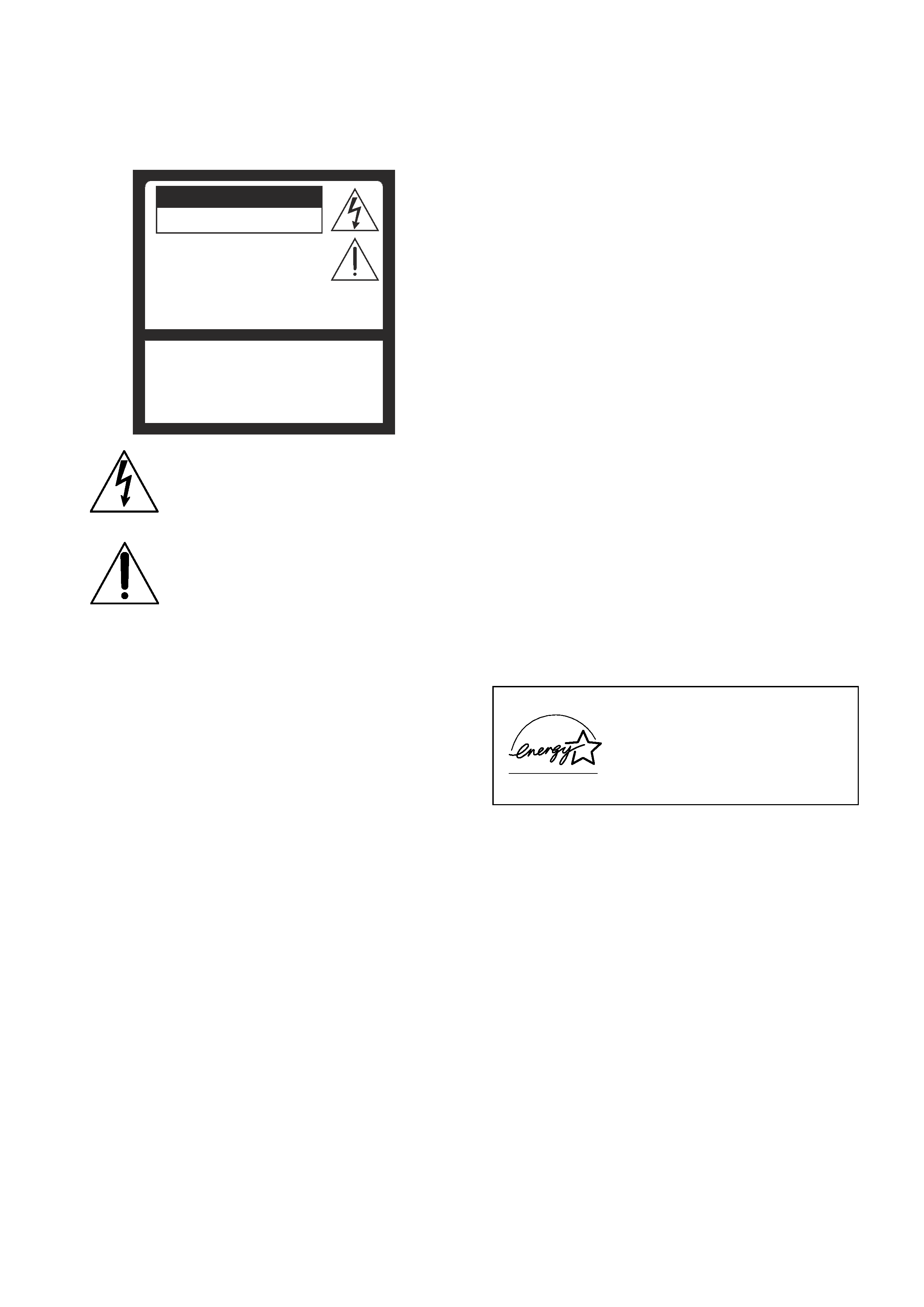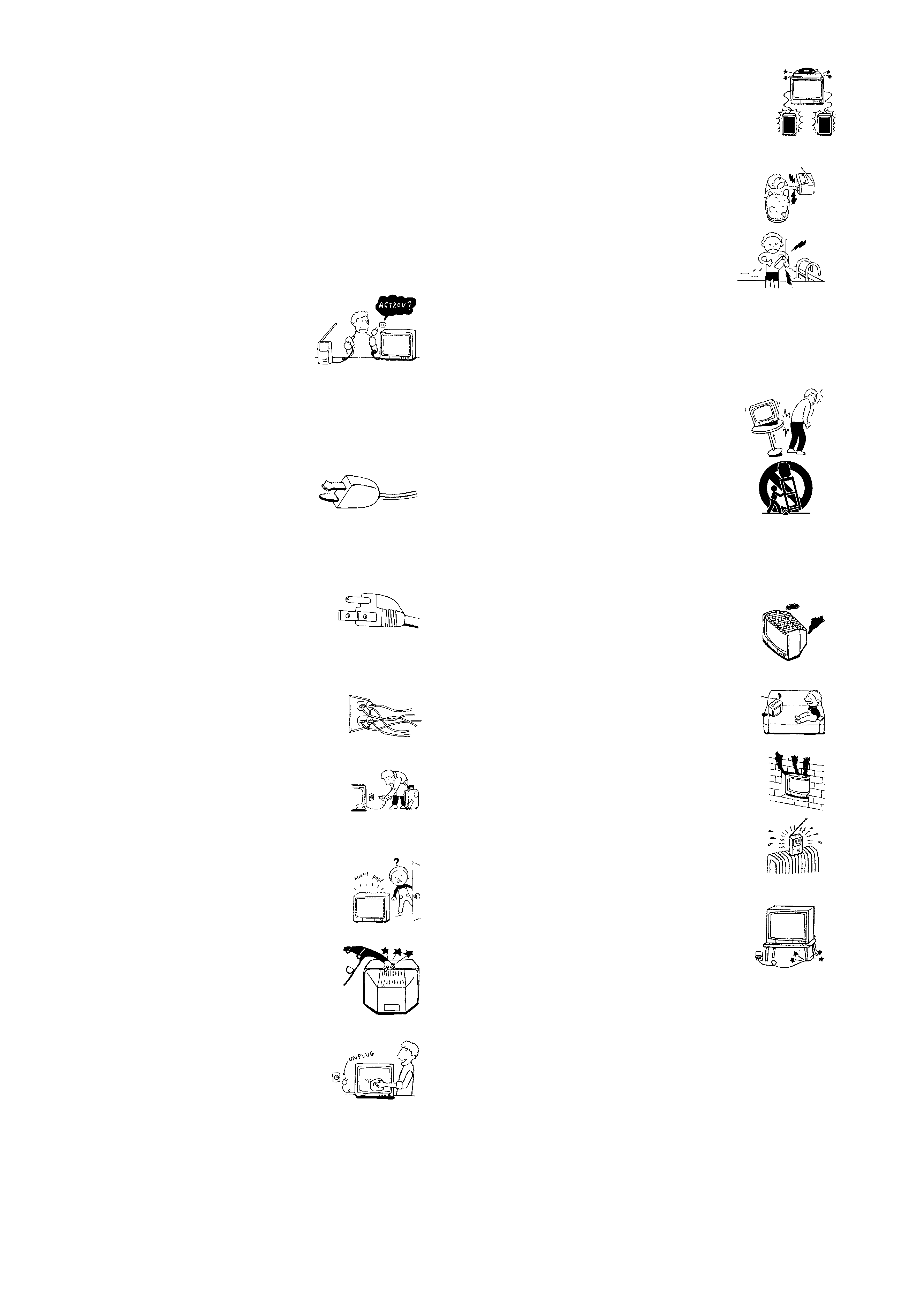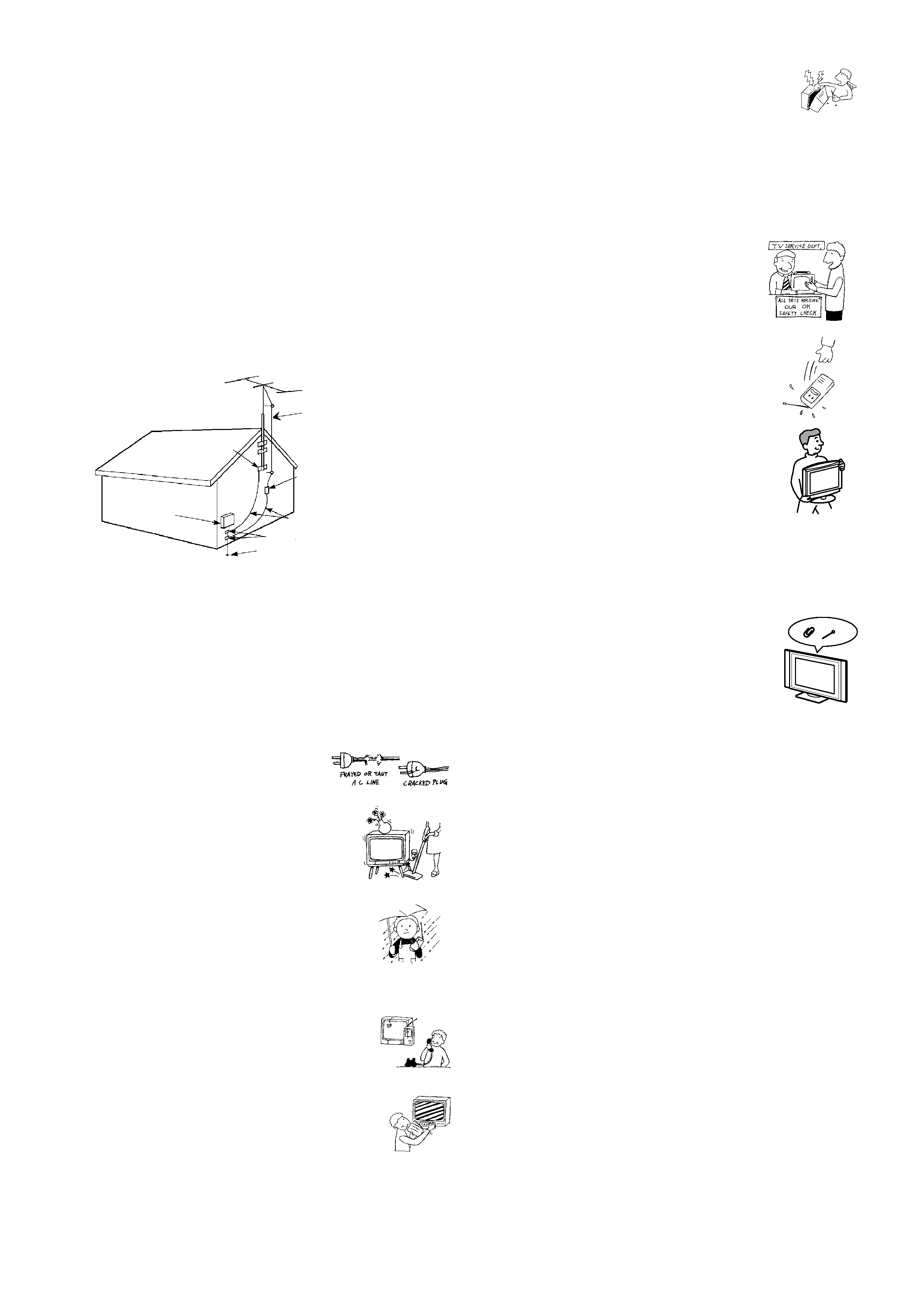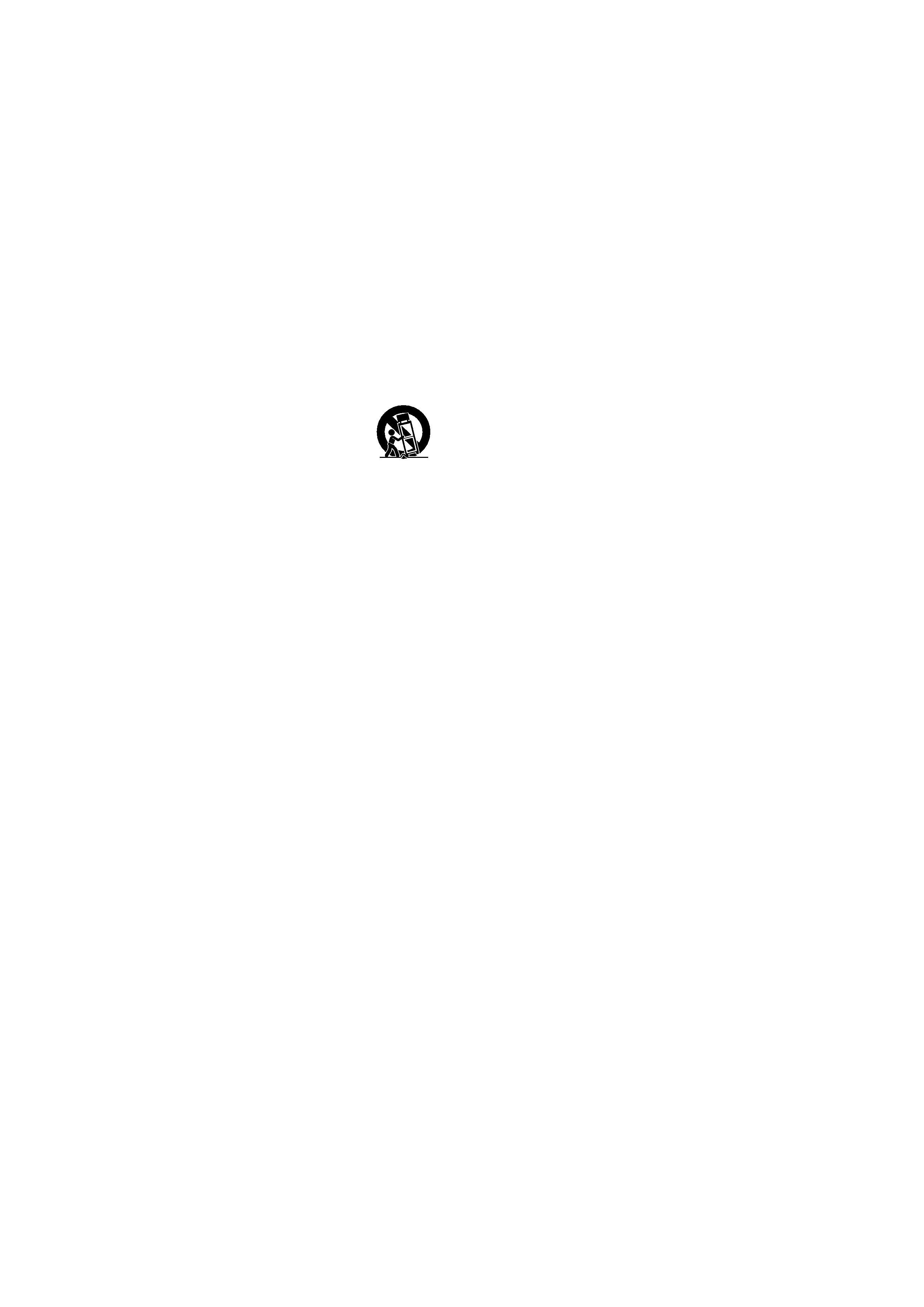
© 2003 Sony Corporation
4-095-486-12 (2)
LCD Color TV
Operating Instructions
Before operating the unit, please read this manual thoroughly
and retain it for future reference.
KLV-15SR1
Owner's Record
The model and serial numbers are located at the rear of the TV, on the backside of
the rear cover, on the sticker, and also on the TV box (white label). Record these
numbers in the spaces provided below. Refer to them whenever you call upon your
Sony dealer regarding this product.
Model No. ________________
Serial No. ________________

2
WARNING
To Reduce the risk of fire or shock hazard,
do not expose the TV to rain or moisture.
This symbol is intended to alert the user to the presence
of uninsulated "dangerous voltage" within the product's
enclosure that may be of sufficient magnitude to
constitute a risk of electric shock to persons.
This symbol is intended to alert the user to the
presence of important operating and maintenance
(servicing) instructions in the literature
accompanying the appliance.
CAUTION
TO PREVENT ELECTRIC SHOCK, MATCH WIDE BLADE OF
PLUG TO WIDE SLOT, FULLY INSERT.
CAUTION
The following SONY appliance for use only with the following WALL-
HANGING RACK UNIT. Use with other WALL-HANGING RACK
UNIT is capable of resulting in instability causing possible injury.
SONY APPLIANCE MODEL NO.
KLV-15SR1
WALL-MOUNT UNIT MODEL NO.
SU-W100
SONY Corp.
Note on Caption Vision
This television receiver provides display of television closed captioning
in accordance with §15.119 of the FCC rules.
Note to CATV system installer
This reminder is provided to call the CATV system installer's attention
to Article 820-40 of the NEC that provides guidelines for proper
grounding and, in particular, specifies that the cable ground shall be
connected to the grounding system of the building, as close to the point
of cable entry as practical.
Use of this television receiver for other than private viewing of programs
broadcast on UHF, VHF, transmitted by cable companies or satellite for
the use of the general public may require authorization from the
broadcaster/cable company and/or program owner.
CAUTION
RISK OF ELECTRIC SHOCK
DO NOT OPEN
ATTENTION
RISQUE DE CHOC ELECTRIQUE,
NE PAS OUVRIR
PRECAUCION
RIESGO DE CHOQUE ELECTRICO
CAUTION : TO REDUCE THE RISK OF ELECTRIC SHOCK,
DO NOT REMOVE COVER (OR BACK).
NO USER-SERVICEABLE PARTS INSIDE.
REFER SERVICING TO QUALIFIED SERVICE PERSONNEL.
NO ABRIR
NOTIFICATION
This equipment has been tested and found to comply with the limits for a
Class B digital device pursuant to Part 15 of the FCC Rules. These limits
are designed to provide reasonable protection against harmful interference
in a residential installation. This equipment generates, uses, and can radiate
radio frequency energy and, if not installed and used in accordance with
the instructions, may cause harmful interference with radio
communications. However, there is no guarantee that interference will not
occur in a particular installation. If this equipment does cause harmful
interference to radio or television reception, which can be determined by
turning the equipment off and on, the user is encouraged to try to correct
the interference by one or more of the following measures:
Reorient or relocate the receiving antennas.
Increase the separation between the equipment and receiver.
Connect the equipment into an outlet on a circuit different from that to
which the receiver is connected.
Consult the dealer or an experienced radio/TV technician for help.
You are cautioned that any changes or modifications not expressly
approved in this manual could void your warranty and your authority
to operate this equipment.
Safety
Operate the TV only on 120 V AC.
The plug is designed, for safety purposes, to fit into the wall outlet
only one way. If you are unable to insert the plug fully into the outlet,
contact your dealer.
If any liquid or solid object should fall inside the cabinet, unplug the
TV immediately and have it checked by qualified service personnel
before operating it further.
If you will not be using the TV for several days, disconnect the power
by pulling the plug itself. Never pull on the cord.
Installing
To prevent internal heat buildup, do not block the ventilation
openings.
Do not install the TV in a hot or humid place, or in a place subject to
excessive dust or mechanical vibration.
ENERGY STAR® is a U.S. registered mark.
As an ENERGY STAR® Partner, Sony
Corporation has determined that this
product meets the ENERGY STAR®
guidelines for energy efficiency.

3
Important Safeguards
For your protection, please read these instructions completely, and keep this
manual for future reference.
Carefully observe and comply with all warnings, cautions and instructions
placed on the set or described in the operating instructions or service
manual.
WARNING
To guard against injury, the following basic safety precautions should be
observed in the installation, use and servicing of the set.
Use
Power Sources
This set should be operated only from the type of
power source indicated on the serial/model
plate. If you are not sure of the type of electrical
power supplied to your home, consult your
dealer or local power company. For those sets
designed to operate from battery power, refer to
the operating instructions.
Grounding or Polarization
This set is equipped with a polarized AC power cord plug (a plug having
one blade wider than the other), or with a three-wire grounding type plug
(a plug having a third pin for grounding). Follow the instructions below:
For the set with a polarized AC
power cord plug
This plug will fit into the power outlet only one
way. This is a safety feature. If you are unable to
insert the plug fully into the outlet, try reversing
the plug. If the plug still fails to fit, contact your
electrician to have a suitable outlet installed. Do not defeat the safety
purpose of the polarized plug by forcing it in.
For the set with a three-wire grounding
type AC plug
This plug will only fit into a grounding-type power
outlet. This is a safety feature. If you are unable to
insert the plug into the outlet, contact your electrician
to have a suitable outlet installed. Do not defeat the safety purpose of the
grounding plug.
Overloading
Do not overload wall outlets, extension cords or
convenience receptacles beyond their capacity, since this
can result in fire or electric shock.
Always turn the set off when it is not being used. When
the set is left unattended and unused for long periods of
time, unplug it from the wall outlet as a precaution
against the possibility of an internal malfunction that
could create a fire hazard.
If a snapping or popping sound from a TV set is
continuous or frequent while the TV is operating, unplug
the TV and consult your dealer or service technician. It is
normal for some TV sets to make occasional snapping or
popping sounds, particularly when being turned on or
off.
Object and Liquid Entry
Never push objects of any kind into the set through the
cabinet slots as they may touch dangerous voltage
points or short out parts that could result in a fire or
electric shock. Never spill liquid of any kind on the set.
Cleaning
s
Be sure to unplug the TV unit before cleaning.
s
Minimize contact with the LCD screen surface
since the special coating applied may be
affected. Use a dry soft cloth when removing
dust from the screen.
s
Do not use alcohol, benzine, thinner, etc., as it may damage the coating
or cause LCD screen deterioration.
s
Always use commercially available chemical fiber cleaning cloths in
accordance with their supplied instructions.
s
Do not allow the LCD screen to come in contact with volatile
compounds, such as insecticide. Also, never let the LCD screen come in
contact with rubber or plastic products for an extended period of time.
This type of contact may damage the coating, or cause the LCD screen
to deteriorate.
Attachments
Do not use attachments not recommended by the
manufacturer, as they may cause hazards.
I
nstallation
Water and Moisture
Do not use power-line operated sets near water -- for
example, near a bathtub, washbowl, kitchen sink, or
laundry tub, in a wet basement, or near a swimming pool,
etc.
Corrosion
Use of this set near the seashore may subject the set to excessive salt,
corrosion and internal damage and result in deterioration of the set's
performance. If the set will be subjected to these conditions, steps should be
taken to reduce the humidity and temperature of the area where the set is
located.
Accessories
Do not place the set on an unstable cart, stand, table or
shelf. The set may fall, causing serious injury to a child
or an adult and serious damage to the set. Use only a
cart or stand recommended by Sony for the specific
model of TV. No part of the TV set should overhang
any edge of the TV cart or stand; any overhanging edge is
a safety hazard. An appliance and cart combination
should be moved with care. Quick stops, excessive force,
and uneven surfaces may cause the appliance and cart
combination to overturn.
Ventilation
The slots and openings in the cabinet and in the back or bottom are
provided for necessary ventilation. To ensure reliable operation of the set,
and to protect it from overheating, these slots and openings must never be
blocked or covered.
s
Never cover the slots and openings with a cloth or
other materials.
s
Never block the slots and openings by placing the set
on a bed, sofa, rug or other similar surface.
s
Never place the set in a confined space, such as a
bookcase or built-in cabinet, unless proper ventilation
is provided.
s
Do not place the set near or over a radiator or heat
register, or where it is exposed to direct sunlight.
Power-Cord Protection
Do not allow anything to rest on or roll over the power
cord, and do not place the set where the power cord is
subject to wear or abuse.

4
Antennas
Outdoor Antenna Grounding
If an outdoor antenna is installed, follow the precautions below. An outdoor
antenna system should not be located in the vicinity of overhead power
lines or other electric light or power circuits, or where it can come in contact
with such power lines or circuits.
WHEN INSTALLING AN OUTDOOR ANTENNA SYSTEM, EXTREME
CARE SHOULD BE TAKEN TO KEEP FROM CONTACTING SUCH
POWER LINES OR CIRCUITS AS CONTACT WITH THEM IS ALMOST
INVARIABLY FATAL.
Be sure the antenna system is grounded so as to provide some protection
against voltage surges and built-up static charges. Section 810 of the
National Electrical Code (NEC) in USA and Section 54 of the Canadian
Electrical Code in Canada provides information with respect to proper
grounding of the mast and supporting structure, grounding of the lead-in
wire to an antenna discharge unit, size of grounding conductors, location of
antenna discharge unit, connection to grounding electrodes, and
requirements for the grounding electrode.
Antenna Grounding According to the NEC
Refer to section 54-300 of Canadian Electrical Code for Antenna Grounding.
Lightning
For added protection for this television receiver during a lightning storm, or
when it is left unattended and unused for long periods of time, unplug it
from the wall outlet and disconnect the antenna. This will prevent damage
to the receiver due to lightning and power-line surges.
Service
Damage Requiring Service
Unplug the set from the wall outlet and refer servicing to qualified service
personnel under the following conditions:
s
When the power cord or plug is damaged or
frayed.
s
If liquid has been spilled into the set.
s
If the set has been exposed to rain or water.
s
If the set has been subject to excessive shock by being dropped, or the
cabinet has been damaged.
s
If the set does not operate normally when following
the operating instructions. Adjust only those controls
that are specified in the operating instructions.
Improper adjustment of other controls may result in
damage and will often require extensive work by a
qualified technician to restore the set to normal operation.
s
When the set exhibits a distinct change in performance,
it indicates a need for service.
Antenna lead-in wire
Antenna discharge unit
(NEC Section 810-20)
Grounding conductors
(NEC Section 810-21)
Ground clamps
Power service grounding electrode
system (NEC Art 250 Part H)
Electrical wire
equipment
Ground clamp
NEC: National Electrical Code
Servicing
Do not attempt to service the set yourself since opening the
cabinet may expose you to dangerous voltage or other
hazards. Refer all servicing to qualified service personnel.
Replacement Parts
When replacement parts are required, be sure the service technician certifies
in writing that he has used replacement parts specified by the manufacturer
that have the same characteristics as the original parts.
Unauthorized substitutions may result in fire, electric shock or other
hazards.
Safety Check
Upon completion of any service or repairs to the set,
ask the service technician to perform routine safety
checks (as specified by the manufacturer) to
determine that the set is in safe operating condition,
and to so certify.
When the set reaches the end of its useful life, improper
disposal could result in an LCD panel implosion. Ask a
qualified service technician to dispose of the set.
Carrying the TV
When carrying the TV, hold it as shown in the diagram on
the right. Do not hold only the rear cover. As the rear cover
comes off easily, doing so may cause you to drop the TV,
resulting in damage to the TV or injury.
Optional Accessories
Be sure to follow the operating instructions supplied with your wall mount
unit when installing the TV using a wall mount unit. If not, the TV may fall
and cause serious injury.
Oils
Do not install this TV in restaurants where oil vapors occur. Dust absorbing
oil may enter into the TV and damage it.
Ventilation holes
Do not insert anything in the ventilation holes. If metal or
something flammable enters, it may result in fire or
electric shock.
AC power cord
Unplug the AC power cord when moving the TV.
Do not move the TV with the AC power cord plugged in. It may damage
the AC power cord and result in fire or electric shock.
Protruding location
Do not install the TV in protruding locations. If you install the TV in the
following locations, injury may result.
s
Do not install the TV in a location where the TV protrudes, such as
pillars.
s
Do not install the TV in a location that may cause facial injury.
Broken pieces
Do not throw anything at the TV.
The screen glass may explode by the impact and cause serious injury.

5
Important Safety Instruction
1)
Read these instructions.
2)
Keep these instructions.
3)
Heed all warnings.
4)
Follow all instructions.
5)
Do not use this apparatus near water.
6)
Clean only with dry cloth.
7)
Do not block any ventilation openings. Install in accordance with the
manufacturer's instructions.
8)
Do not install near any heat sources such as radiators, heat registers,
stoves, or other apparatus (including amplifiers) that produce heat.
9)
Do not defeat the safety purpose of the polarized or grounding-type
plug. A polarized plug has two blades with one wider than the other. A
grounding type plug has two blades and a third grounding prong. The
wide blade or the third prong are provided for your safety. If the
provided plug does not fit into your outlet, consult an electrician for
replacement of the obsolete outlet.
10) Protect the power cord from being walked on or pinched particularly
at plugs, convenience receptacles, and the point where they exit from
the apparatus.
11) Only use attachments/accessories specified by the manufacturer.
12) Use only with the cart, stand, tripod, bracket, or table
specified by the manufacturer, or sold with the apparatus.
When a cart is used, use caution when moving the cart/
apparatus combination to avoid injury from tip-over.
13) Unplug this apparatus during lightning storms or when unused for
long periods of time.
14) Refer all servicing to qualified service personnel. Servicing is required
when the apparatus has been damaged in any way, such as power-
supply cord or plug is damaged, liquid has been spilled or objects have
fallen into the apparatus, the apparatus has been exposed to rain or
moisture, does not operate normally, or has been dropped.
Handling the LCD screen
s
Do not leave the LCD screen facing the sun as it can damage the LCD
screen. Take care when you place the TV by a window.
s
Do not push on or scratch the LCD screen. Do not place a heavy object
on the LCD screen. This may cause the screen to lose uniformity or
cause LCD panel malfunctions.
s
If the TV is used in a cold place, a smear may appear on the screen.
This is not a malfunction. The screen returns to normal as the
temperature rises to a normal operating level.
s
If a still picture is displayed for a long time, a ghosting may occur for a
while. The ghosting will eventually disappear.
s
The LCD panel becomes warm during operation. This is not a
malfunction.
Note on the LCD (Liquid Crystal Display)
Please note that the LCD screen is made with high-precision technology.
However, black points or bright points of light (red, blue, or green) may
appear constantly on the LCD screen, and irregular colored stripes or
brightness may appear on the LCD screen. This is not a malfunction.
(Effective dots: more than 99.99%)
Handling of Broken Glass and Liquid Crystal Leakage
If the LCD panel gets damaged, crystalline liquid leakage may occur, or
scattered broken glass may result. Do not touch broken glass or crystalline
liquid (which is toxic), with bare hands as cuts or poisoning/skin irritation
may occur. Also, do not let glass fragments or leaked crystalline liquid get
into your eyes or mouth. Should either contact your eyes or mouth, rinse
the contacted area thoroughly with water and consult your doctor.
Fluorescent Lamp
This TV uses a special fluorescent lamp as its light source. If the screen
image becomes dark, flickers or does not appear, the fluorescent lamp has
run down and should be replaced. For replacement, consult qualified
service personnel.
Disposal of the TV
s
Do not dispose of the TV with general household waste.
s
The LCD contains a small amount of liquid crystal and mercury. The
fluorescent lamp used in this TV also contains mercury. Follow your
local ordinances and regulations for disposal.
